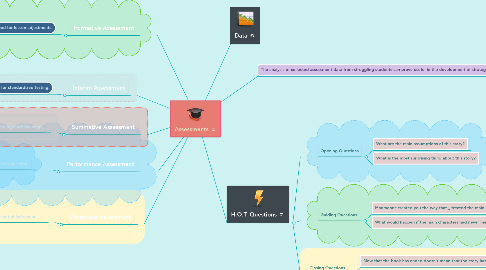
1. Diagnostic Assessment
1.1. Definition: A pre-assessment which enables the teacher to assess the strengths and weaknesses of all students (what they know vs. what they need to know). This is primarily used to guide the development of instruction.
1.1.1. Student survey: after introducing a new topic, but before teaching any content, have student write down everything they know about the given topic.
1.1.2. Unit Vocabulary: go over the new words for the unit and have students write ways they have heard the words used and what they think the definition could be.
2. Performance Assessment
2.1. Definition: Assessment bases upon the completion of a task and not the answering of a question.
2.1.1. Examples: Journals, Projects, Collaborations, Portfolios, and Logs
3. Formative Assessment
3.1. Definition: The cycle of gathering evidence, evaluating the data, giving/getting feedback, and making alterations for future lessons. Main purpose is for teachers to determine the need for lesson adjustments.
3.1.1. Informal Formative Assessment: includes observations, discussions, and questioning. Tends to be initiated spontaneously and yields instant reactions on behalf of the teacher: instruction adjustments and feedback. Used to gauge student performance.
3.1.2. Formal Formative Assessment: includes six types: pretests, quizzes/tests, homework assignments, class work, response systems, and structured exercises. These are planned in advance and offer more detailed and accurate data about achievement.
4. Summative Assessment
4.1. Definition: Assesses how well a large amount of information has been learned/retained. Usually done at the end of a unit, semester, or school year. Main purpose is to measure student achievement.
4.1.1. Examples: Standardized tests, midterm/final exams, end-of-year projects.
5. Interim Assessment
5.1. Definition: Assessments given about every six weeks to determine wether or not students are on track. A type of formal assessment. Main purpose is to determine student progress and readiness for standardized testing.
5.1.1. Examples: Benchmark tests, and district tests, can be written, or project based.
6. The analysis of collected assessment data from struggling students can prove useful in the development of strategies aimed to improve class instruction. This data was collected from three third grade students in reading curriculum.
6.1. Student 1: Scaled Score- 85. Grade equivalent reading level is 1.3
6.2. Student 2: Scaled Score- 247. Grade equivalent reading level is 2.3
6.3. Student 3: Scaled Score- 143. Grade equivalent reading level is 1.7
6.3.1. All 3 students are primarily struggling with reading comprehension. Therefore, strategies focusing on improvement in this area will prove beneficial for all.
6.3.1.1. Strategy 1: Facilitate small group discussions about what is being read. Stop and discuss each chapter.
6.3.1.2. Strategy 2: Have students generate questions about the text and read to discover the answers.
7. Data
8. H.O.T. Questions
8.1. Opening Questions
8.1.1. What are the main assumptions of this story?
8.1.2. What is the most surprising thing about this story?
8.2. Guiding Questions
8.2.1. If someone treated you the way that _____ treated the main character what would you say to them?
8.2.2. What would happen if the main characters had never met?
8.3. Closing Questions
8.3.1. Now that the book has ended doesn't mean that the story has to, what do you think will happen to the two main characters?
8.3.2. How do the ideas presented in this story connect to what we have been learning in class?
